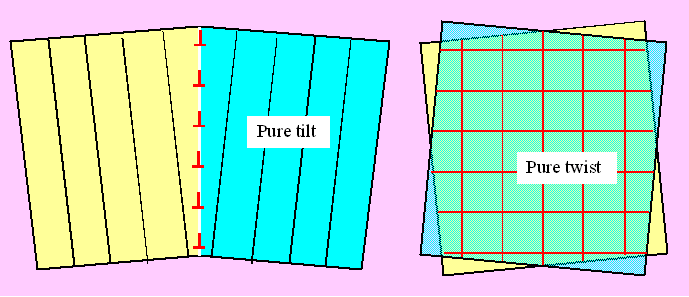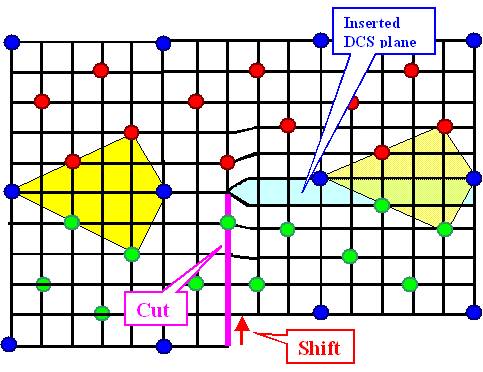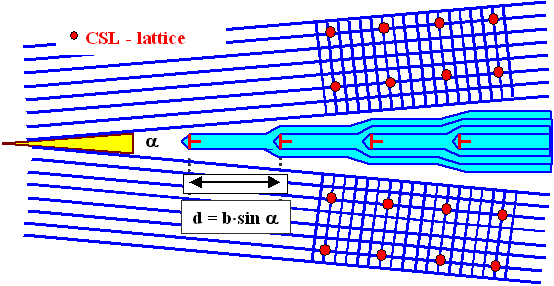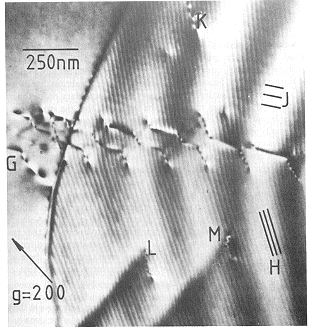 |
The determination of the precise
dislocation structure needed to transform a near-coincidence boundary into a true coincidence boundary with some superimposed
grain boundary dislocation network can be exceedingly difficult (to you, not to
the crystal), especially when the steps possibly associated with the grain
boundary dislocations must be accounted for, too. |
|
 |
Nevertheless, the structure thus obtained is what
you will see in a TEM picture - the crystal has no problem whatsoever to
"solve" this problem! |
 |
In order to get familiar with the
concept, it is easiest, to consider the environment of the Σ= 1 grain boundary, i.e. the boundary between two
crystals with almost identical orientation.
|
|
 |
This kind of boundary is known as "small-angle grain boundary"
(SAGB) , or, as already used
above as "Σ1 boundary". |
|
 |
We can easily imagine the two extreme cases: A
pure tilt and a pure
twist boundary; they are
shown below. |
|
|
|
|
|
|
|
|
|
|
 |
Obviously, we are somewhat off the Σ1 position. Introducing grain boundary dislocations
now will establish the exact Σ1 relation
between the dislocations (and something heavily disturbed at the dislocation
cores). The DSC-lattice as well the CSL are identical with the
crystal lattice in this case, so the grain-boundary dislocations are simple
lattice dislocations. |
|
 |
Introducing a sequence of edge dislocations in the
tilt case and a network (not necessarily square) of screw dislocations in the
twist case will do the necessary transformation; this is schematically shown
below |
|
|
|
|
|
|
|
|
|
 |
This may not be directly obvious, but
we will be looking at those structures in great detail in the next paragraph.
Here we note the important points again: |
|
 |
Between the dislocation lines we now have a
perfect Σ1
relation (apart from some elastic bending). |
|
 |
All of the misfit relative to a perfect Σ orientation is concentrated in the grain boundary
dislocations. |
|
 |
We thus lowered the grain boundary energy in the area
between the dislocations and raised it
along the dislocations - there is the possibility of optimizing the grain
boundary energy. The outcome quite generally is: |
 |
Grain boundaries
containing grain boundary dislocations which account for small misfits relative
to a preferred (low) Σ orientation, are in
general preferable to dislocation-free boundaries. |
|
 |
The Burgers vectors of the grain boundary
dislocations could be translation vectors of one of the crystals, but that is
energetically not favorable because the Burgers vectors are large and the
energy of a
dislocation scales with Gb2 and there is a much
better alternative: |
|
 |
The dislocations accounting for small deviations
from a low Σ orientation are dislocations in the DSC lattice belonging to
the CSL lattice that the grain boundary
Σ endeavors to assume. Why should that be so?
There are several reasons: |
|
 |
- Dislocations in the DSC lattice belong to both crystals since the DSC lattice is
defined in both crystals.
- Burgers vectors of the DSC lattice are smaller than Burgers vectors
of the crystal lattice, the energy of several DSC lattice dislocations
with a Burgers vector sum equal to that of a crystal lattice dislocations thus
is always much smaller. With
Σibi(DSC) =
b(Lattice), we always have
Σibi2(DSC)
<< b2(Lattice).
This is exactly the same consideration as in the
case of lattice dislocations split into partial dislocations.
- A dislocation arrangement with the same "Burgers vector count" along some arbitrary
vector r produces exactly the same displacement (remember
the basic Volterra definition and the
double cut
procedure).
|
 |
In other words: We can always imagine
a low angle boundary of crystal lattice dislocations that produces exactly the
small misorientation needed to turn an arbitrary boundary to the nearest low
Σ position and superimpose it on this
boundary. |
|
 |
Next, we decompose the crystal lattice
dislocations into dislocations of the DSC lattice belonging to the low
Σ orientation. |
|
 |
This will be the dislocation
network that we are going to find in the real boundary! |
 |
Lets illustrate this. First we
construct another kind of DSC lattice dislocation, very similar, but
different to the one we had before.
The coincidence points are marked in blue, atoms of the two crystal lattices in
green and red. |
|
 |
The plane of the cut now is perpendicular to the
boundary and extends, by necessity, all the way to the boundary. We produced a
DSC edge dislocation with a Burgers vector perpendicular to the boundary
plane (and a step of the boundary plane). |
|
|
|
|
|
|
 |
If we were to repeat this procedure
at regular intervals along the boundary, we obtain the structure schematically
outlined below. |
|
|
|
|
| |
|
 |
In essence, we superimposed a tilt
component with a tilt angle α that for small
angles is given by is given by |
|
|
|
|
|
|
 |
with d = spacing of the DSC
lattice dislocations and b = Burgers vector of the DSC
lattice dislocations. |
 |
In short, we can do everything with
DSC lattice dislocations in a grain boundary that we can do with crystal
lattice dislocations. This leads to the crucial question
alluded to before: |
|
 |
How do we calculate the DSC-lattice? As an example for
the most general case of grain boundaries in triclinic lattices? Or even worse:
For phase boundaries between two different
lattices (with different lattice constants)? |
 |
The answer is: Use the "Bollmann
theory or "O-lattice theory" - it covers (almost)
everything. |
|
 |
However, unless you are willing to devote a few
months of your time in learning the concept and the math of the
O-lattice theory, you will encounter problems - it is not an easy
concept to grasp. |
|
 |
We will deal with the
O-lattice theory in a
backbone II section, here we note that the most important cases have been
tabulated. Some solutions for fcc crystals
are given in the table: |
|
|
|
|
|
| Σ |
Generation |
b from DSC-lattice |
| 1 |
"Small-angle GB" |
a/2 <110>, possibly split into partials |
| 3 |
Twin |
a/6 <112>, a/3 <111> |
| 5 |
37° around <100> |
a/10 <130> |
| 9 |
39,9° around <110> |
1/18<114>, 1/9<122>, 1/18<127>, |
| 19 |
26,5° around <110> |
a/38 <116>, a/19<133>, a/19 <10,9,3> |
| 41 |
12,7° around <100> |
a/82<41,5,4>, a/82<910>, ... |
|
|
|
|
|
 |
Interestingly (and very satisfyingly), the
DSC lattice vectors belonging to the Σ =
3 boundary are our
old
acquaintances, the partial Burgers vectors associated with stacking faults
in the crystal lattice. |
|
 |
This is but natural - a Σ = 3 twin boundary is after all a very close relative
to stacking faults. |
 |
Now a question might come up:
Σ = 41 is not exactly a "low
Σ" value; and Burgers vectors of
a/82<41,5,4> appear to be a bit odd, too. So does this still make
sense? Are boundaries close to a Σ41
orientation still special and bound to have grain boundary dislocations? |
|
 |
Only the experiment can
tell. The following TEM picture shows a Σ41 grain boundary (from Dingley and Pond, Acta Met.
27, 667, 1979) |
|
|
|
|
|
 |
A network of grain boundary dislocations with Burgers vectors
b = a/82 <41,5,4> and an average distance of 20 nm is
visible. The two sets of dislocations run parallel to the lines indicated by
H and J. |
 |
Sorry, but it is there, even at Σ = 41. Why - we do not really know, although Bollmann
theory does provide an answer on occasion. |
|
|
 |
Obviously, if you want to understand
the structure of grain boundaries, you must accept the concept of grain
boundary dislocations even at rather large values of Σ and correspondingly low values of the Burgers
vectors. |
 |
In the next paragraph we will study
some cases in more detail. |
© H. Föll




